Melbourne city is located on the coast of southeastern Australian and it is the capital of the state of Victoria.
The Kulin Aboriginal People
The Kulin Aboriginal people lived a hunter-gatherer lifestyle in south, central Victoria, Australia, in an area which includes modern-day Melbourne. It is estimated that before European settlement, this area of central Victoria was inhabited by the Aboriginal people for somewhere between 60,000 to 100,000 years.
During the 1830s, when European settlement of Victoria was underway, it is estimated that the collective populations of the Woiwurrung, Boonwurrung and Wathaurong tribes of the Kulin was under 20,000 people. Today,
An Aboriginal heritage walk is available at Melbourne's Royal Botanic Gardens, which provides insight into the rich and diverse Aboriginal culture of this area.
 |
| Kulin nation man and 2 boys of the Port Phillip region, Melbourne, 1847. Photo: Douglas T. Kilburn |
1802
The first known Europeans in the Melbourne region were George Bass and crew, sailing on a whaling boat, entering what came to be called Bass Strait, the passage between the Australian mainland and Van Diemen's Land (Tasmania). Bass sailed along what is now the coast of the Gippsland region of Victoria.
In 1802, John Murray in the
Lady Nelson entered Port Phillip; he was followed shortly after by Matthew Flinders.
 |
| Print, View of the Lady Nelson in the Thames, from an engraving by Samuel John Neele. |
Charles Grimes, who was the deputy surveyor-general of New South Wales, was sent in 1803, to Port Phillip to survey the area, aboard the
Cumberland. On that assignment, Lieutenant Charles Robbins, the commander of the expedition and Grimes, met about 30 members of the local Aboriginal population. On returning to Sydney, Grimes made a report advising against a settlement of the Port Phillip area.
However, fearful that the French would attempt to occupy the Bass Strait area, the British Governor of New South Wales sent Colonel David Collins, with a group of 300 convicts, to establish a settlement at Port Phillip. Initially, the group settled
at Sorrento, on the Mornington Peninsula, in October of 1803; but because of the lack of drinking water, the settlement moved to Tasmania, leading to the establishment of
Hobart.
1830s
In 1835 John Batman a grazier, claimed that he had bought 600,000 acres (2,400 km2) of land around Melbourne
from the Aboriginal people. Batman planned to settle the land. But another man, a fellow Tasmanian, John Pascoe, sent a party of colonists from Launceston.
This group were already camping on the Yarra River before the arrival of Batman's group. Neither group had official permission to settle the district, but soon, the Colonial Secretary in London approved the Port Phillip occupation, and Captain William Lonsdale
arrived to act as a magistrate and arrange the sale of land.
Batman wrote in his diary that when he came upon the current site of central Melbourne on 8 June 1835, "This will be the place for a village", and calling the land "Batmania".
The grid of streets that is now central Melbourne was laid out by surveyor Robert Hoddle when he arrived at the unauthorised settlement in early 1837, along with New South Wales Governor Bourke.
After Gov. Bourke inspected the new colony in 1837, he gave authorisation for establishing a town along the Yarra, which was to be called Melbourne, after Lord Melbourne, the Prime Minister of Britain.
 |
| Portrait of Sir Richard Bourke, Governor of New South Wales, by Martin Archer Shee c. 1837-1850. |
James Strachan purchased land at the first local land sale and in 1838, built one of Melbourne's first brick buildings, which still stands.
The first lots of land, were sold in Melbourne in June 1837, but the area grew at such a lightning speed that the Melbourne Advertiser, reported that those who left Melbourne for a few days, on their return, "express pleased feelings of surprise at the very evident advancement of this flourishing, but newly settled town". Interestingly, early issues of this particular newspaper were handwritten by John Pascoe Fawkner (mentioned above).
A post office was first established in Melbourne on 13 April 1837.
Arden, the author of a
pamphlet written on Port Phillip in 1838, described Melbourne as having "more the appearance of the villages he had seen in the interior of India". However, after six months' absence, Arden expressed surprise at the "general improvement and rapid progression of Melbourne".
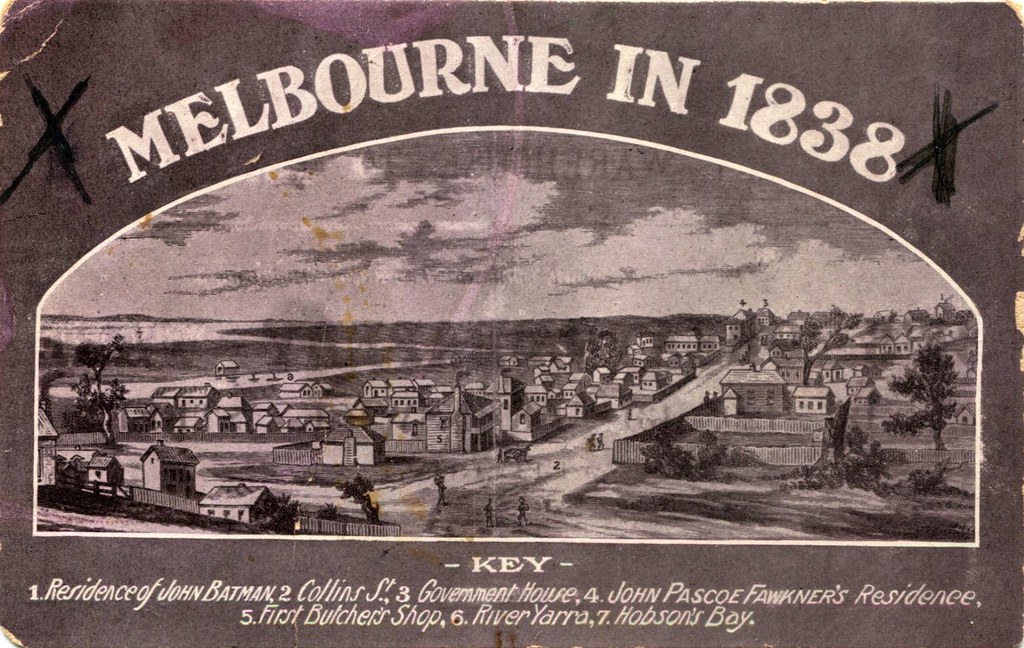 |
Melbourne in 1838
1. Residence of John Batman (in the distance on the right)
2. Collins Street
3. Government House (on the horizon)
4. John Pascoe Fawkner's residence (next to Government house)
5. First butchers shop (centre foreground)
6. River Yarra
7. Hobson's Bay
Kaye |
 |
| Collins Street, Melbourne, VIC, 1839. Watercolour by W. Knight |
Melbourne Athenaeum was Founded in 1839. Originally called the Melbourne Mechanics' Institute.
Immigrants
were flooding into the town from Tasmania, Sydney, England and Scotland, and by 1839, the population stood at about 5800 people.
In 1839, Melbourne had about six shoemakers, two saddlers, three bakers, four butchers and three tailors. There was no watchmaker, however, and only one person with legal qualifications by the name of Meek. So, Fawkner and a butcher named M'Nall were allowed to act as advocates before the Police Magistrate.
 |
| Landing at Melbourne, scanned image of watercolor by W. F. E. Liardet (1830). Captain Wilbraham Frederick Evelyn Liardet settled on the sands of Hobsons Bay in late 1839 and constructed a jetty and hotel, and establishing a mail and ferry service. He also painted the early settlement in watercolour |
Henry Gilbert Jones, who studied pharmacy and art in Britain, arrived in Australia in 1840. He set up a pharmacy in Bourke Street and was also appointed medical dispenser to the Aboriginal people of Melbourne and Westernport by Superintendant Latrobe (
1.). This building is now the Elephant and Wheelbarrow Hotel on the corner of Bourke and Exhibition streets.
 |
| Original GPO building shortly after construction in 1841. State Library of Victoria Pictures Collection. |
Jones also made lithographs of Bourke Street East in 1848, a small pen drawing of Bourke Street at the corner of Stephen Street (now Exhibition Street) about 1846, and a large copper plate of an Aboriginal corroboree. These all appear to be privately owned.
Mary Gilbert was the wife of a blacksmith named James Gilbert. She was the first European woman to live at the British settlement of Melbourne and her son was the first European
child born there in 1835. The couple arrived on the ship
Enterprize, with Melbourne's first cat.
 |
| The Lady Mayoress, Mrs. R. Walker unveiled a statue of the pioneer Mary Gilbert by sculptor Ailsa O'Connor in the Conservatory, Fitzroy Gardens on the 26th November, 1975 |
Around 1839, Tasmanian (Palawa) Aboriginal woman Truganini arrived in Melbourne. After about two years of living there, she joined Tunnerminnerwait and three other Tasmanian Aboriginal people who became outlaws, robbing and shooting at settlers around Dandenong. The group also killed two whale hunters. Oral stories claim that the group killed the whale hunters due to their mistreatment of Aboriginal women.
_p187_TASMANIA%2C_THE_LAST_OF_THE_ABORIGINALS_(LADY).jpg) |
| Truganini (Trugernanner) in 1870. Truganini is often referred to as the last Tasmanian Aboriginal person, which is untrue. She was, however, the last known full-blooded Aboriginal member of the Palawa people. Truganini grew up in Tasmania and lived through great tragedy and horrors. Her mother and first fiance were killed by whalers and her sisters, Lowhenunhue and Maggerleede, were abducted and taken away to South Australia. Truganini then met George Augustus Robinson, who was the Chief Protector of Aborigines and she moved to the Port Philip colony (later Melbourne) to help him negotiate a peace settlement with mainland Aboriginal people. However, Truganini spent two years living around Melbourne and in that time she joined a group of Aboriginal outlaws who murdered two whalers at Watson's hut. |
1840s
St James Old Cathedral, the oldest church in Melbourne (1847)
 |
| St James Old Cathedral, the oldest church in Melbourne, VIC (1847) |
1850s: A Separate Colony and Gold
In 1850, Victoria became a separate colony. Then, on the day after the colony of Victoria was proclaimed, in July 1851, came the announcement that gold had been found at Warrandyte, near Melbourne. Soon after, gold was also found at
Ballarat and the gold rush began.
With the
gold rush, Melbourne suddenly became almost deserted, as most men rushed off to try their luck at striking it rich. But Melbourne was soon enough thronging with people again, as not only did people from other Australian colonies rush to Melbourne but so did immigrants from places like Great Britain, Ireland, Europe, the United States and China; so that in 1851, the population of Melbourne was 23 000 people and rapidly rising.
The Duke of Wellington Hotel in Melbourne CBD (cnr William and Flinders Lane) was completed in 1850.
 |
| The Duke of Wellington Hotel in Melbourne CBD (cnr William and Flinders Lane) was completed in 1850 |
Melbourne Cricket Ground was built in 1853.
 |
| THE ABORIGINALS AT THE EXHIBITION BUILDING ON HER MAJESTY'S BIRTHDAY.FROM A DRAWING BY N. CHEVALIER, ESQ. Chevalier arrived in Melbourne in 1854 and found employment on the magazine, Melbourne Punch. The first exhibition building was closed and demolished in 1861 as it was deemed too small for future exhibitions. Sir Redmond Barry, founder and trustee of the Public Library and Museum, and Chancellor of the University of Melbourne, offered the grounds of the Public Library and Museum to serve as a temporary venue for the exhibitions. |
 |
| Portrait of John Pascoe Fawkner, founder of Melbourne, 1856 |
Many of the people coming into Melbourne set up their home in tents. This led to a "Canvas Town" being legalised by Governor LaTrobe in 1852. However, a weekly rent of five shillings per tent was imposed. Melbourne was at this time, the fastest growing city in the world.
Melbourne was a place that the English writer, Antony Trollope, described as "the undoubted capital of Australia". And this was only forty years after Melbourne's foundation.
 |
| Canvas Town, South Melbourne in the 1850s |
In writing about Melbourne only a few years later,
Richard Twopenny, a journalist and newspaper owner, said: "Although Sydney is the older town, Melbourne is justly entitled to be considered the metropolis of the Southern Hemisphere."
He also said, "If you are a man of leisure you will find more society in Melbourne, more balls and parties, a larger measure of intellectual life --i.e., more books and men of
education and intellect, more and better theatrical and musical performances, more racing and cricket, football, and athletic clubs, a larger leisured class than in Sydney."
 |
| Queens Wharf in Melbourne, Victoria - 1850s, Aussie Mobs |
Melbourne Welsh Church was established in 1857, on La Trobe Street.
In 1858 a design competition was held for a new General Post Office building.
Melbourne Grammar School founded in 1858.
The Old Treasury Building on Spring Street in Melbourne was built 1858-62.
 |
| Treasury building, Melbourne, VIC, 1859, NLAUST |
1860sThe Queen Victoria Market was built from the 1860s.
 |
| Railway Station, Melbourne, howing railway yards, engines and carriages on tracks, men standing around yard, sheds in right background, and station in left background. The engine in the center is 2-4-0 saddle tank no, 30 of the L class, while those to the right are 2 of the first J class passenger engines nos. 10 and 4. Circa 1861 |
The Melbourne CupFrederick Charles Standish (1824 –1883) is credited with the Melbourne Cup. In England, Standish was a frequent gambler on English racecourses. However, after he lost a significant amount of money, he left England for Australia in 1852 and in 1861, the famous horse race began, with a prize of 710 gold sovereigns.
1870s
 |
| Elevated view over rooftops and St Kilda road towards Melbourne, VIC, shows bridge over Yarra and St Paul's Church (later St. Paul's Cathedral). Circa 1870 |
Horticultural Hall (also known as 'Horti Hall') opened in 1873
. |
| Swanston Street, Melbourne, VIC, ca. 1873 Charles Nettleton State Library Victoria |
Government House, located in Kings Domain, Melbourne, was opened in 1876, on land that had originally been set aside in 1841.
The Victorian Academy of Music in Bourke Street, Melbourne, was built for Samuel Aarons in 1876. It was also advertised as the Bijou Theatre.
In July 1879, a Melbourne engineering firm, Robison Brothers, installed a telephone between their Flinders Street offices and foundry in South Melbourne.
 |
| MELBOURNE EXHIBITION BUILDING UNDER CONSTRUCTION, VIC - 1879 - 1880, Aussie Mobs |
1880s
 |
| Photograph of buildings and horse drawn carriages in Bourke Street West, Melbourne, VIC, ca.1880. Shop signs include: Jones & Co's Sewing Machines, Hosie's Baths Hotel, Wallworth & ? Rimmington Hat Manufacturers, and Foley's Hotel & Dining Rooms. A lamp post sign (l.r.) reads: "Walking over crossing." State Library Victoria Collections |
 |
| 1880s, Melbourne, Collins St, VIC, East towards Treasury Building. Photographer Charles Nettleton, Carl Guderian |
 |
| Melbourne's first cable tram service on 11 November 1885, VIC |
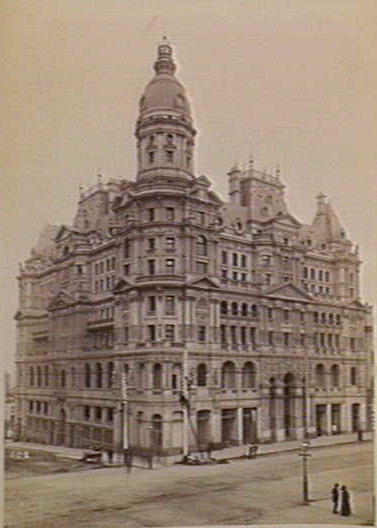 |
The Federal Coffee Palace, a temperance hotel was the largest and tallest building in Melbourne. Built in 1888.
|
The Austral Building was built in 1890, for magazine publisher Alexander McKinley & Co., best known for the Melbourne Punch.
 |
"THE BLOCK," COLLINS-STREET, MELBOURNE : SATURDAY MORNING. The well-frequented promenade in Collins-street, called "The Block," is the portion on the north side, bounded by Elizabeth and Swanston streets. Music shops, cafes, libraries, and the Athenaeum Club are within its boundaries. Australasian (Melbourne, Vic. : 1864 - 1946), Saturday 11 February 1899 |
Melbourne Savage Club, a private Australian gentlemen's club, was founded in 1894 and named after the poet Richard Savage to bring together literary men.
The gold rush had brought boom times to Melbourne, and within a decade, Melbourne's population
increased over ten times its size. Then, in the early 1890s, the bust came. Banks and businesses failed in great numbers, and mass unemployment caused misery for many.
Melbourne recovered slowly from these blows, transforming from a brash and optimistic place to developing a more conservative and considered character. And then, over time,
slowly transforming yet again, by becoming a progressive, forward-looking city. But a place that generally respects its heritage and preserves it with care.
1900s
 |
| Parliament House, Melbourne, VIC, Critic (Adelaide, SA : 1897-1924), Saturday 15 December 1900 |
 |
| The Yarra River from Princes Bridge, Melbourne, Victoria - possibly pre 1900, Aussie Mobs |
Australia became a nation on 1 January 1901.
The Art Nouveau style Milton House at 21–25 on Flinders Lane was built in 1901.
 |
| The Imperial Troops in Collins-Street, Melbourne, VIC, Australian Town and Country Journal (Sydney, NSW : 1870 - 1919), Saturday 9 February 1901 |
 |
| The Chinese Procession in Swanston Street, Melbourne, VIC, Punch (Melbourne, Vic. : 1900 - 1918; 1925), Thursday 9 May 1901 |
 |
| The Stockmen's Procession Swanston Street, Melbourne, VIC, Punch (Melbourne, Vic. : 1900 - 1918; 1925), Thursday 9 May 1901 |
 |
| VICTORIAN BUSHMEN'S CONTINGENT in SWANSTON STREET, MELBOURNE, VICTORIA - circa 1901, Aussie Mobs |
The City Baths at 420 Swanston Street, Melbourne, opened in 1904 as public baths.
 |
| The Professional Musicians' Union of Melbourne., VIC, Punch (Melbourne, Vic. : 1900 - 1918; 1925), Thursday 25 June 1903 |
 |
| Punch (Melbourne, Vic. : 1900 - 1918; 1925), Thursday 7 September 1905 |
 |
| INTERSTATE LADIES' CRICKET MATCH.-TASMANIA V. VICTORIA. PLAYED AT VICTORIA PARK, COLLINGWOOD, VIC, Punch (Melbourne, Vic. : 1900 - 1918; 1925), Thursday 22 March 1906 |
 |
| Cable tram dummy and trailer on the St Kilda Line in Melbourne, VIC, in 1905 |
 |
| Melbourne, VIC, 1908, Internet Archive Book Images |
 |
| Punch (Melbourne, Vic. : 1900 - 1918; 1925), Thursday 20 August 1914 |
 |
| Looking down Flinders Lane, building in left foreground signed "Paterson Laing & Bruce Limited", horse drawn vehicles on road, cars lining curbs, pedestrians on paths -- Closer view of cars and horse-drawn vehicles. ca. 1891 - ca. 1914, SLVIC |
 |
| Melbourne City Baths, VIC — circa 1914, SLVIC |
The Former Melbourne Magistrates' Court opened in 1914.
1920s |
| Victoria Market, Melbourne, Victoria - circa 1920, Aussie Mobs |
 |
| Coffee Room for Dominoes, Chess etc at the Commercial Travellers' Club in Melbourne, Victoria - 1920s. Now the Rendezvous Grand Hotel. Aussie Mobs |
 |
| The Oriental Hotel, Collins Street, Melbourne, Victoria - 1923, Aussie~mobs |
 |
| The Church Street bridge (opened in 1923), Melbourne, VIC, in 1924. The first bridge on the site was an iron girder bridge built in 1857. |
.jpg) |
| Exterior of Regent Theatre, Melbourne, VIC, 1924 |
 |
| Migrants in Melbourne Arrivals fromn Southern Europe by the steamer Re d'Atalia.News (Adelaide, SA : 1923 - 1954), Tuesday 30 December 1924 |
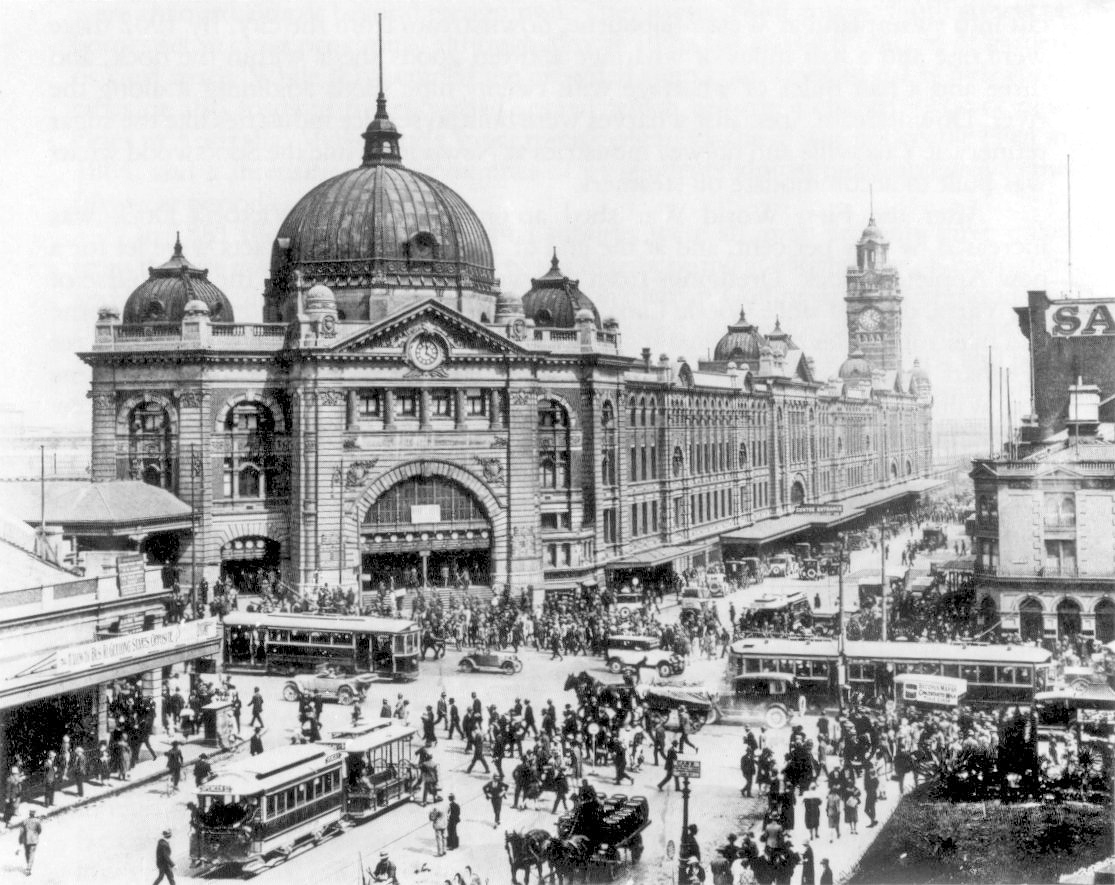 |
| Flinders Street station, intersection of Swanston and Flinders Streets in 1927 when it was the world's busiest passenger station, Melbourne, VIC |
 |
| Collins Street, Melbourne, n.d. |
 |
| Anzac Day Parade in Melbourne, Victoria - 1927, Aussie Mobs, held during the visit of their R. H. The Duke and Duchess of York in Melbourne. Picture shows procession crossing bridge at Flinders Street Station and proceeding up Swanson Street. (should be Swanston Street) |
 |
| March of Melbourne unemployed, Weekly Times (Melbourne, Vic. : 1869 - 1954), Saturday 28 January 1928 |
Economic markets around the world fell and global economic forces severely impacted communities and individuals.
1930s
 |
| Phar Lap winning the Melbourne Cup Race from Second Wind and Shadow King on 5th November, 1930 |
 |
| State Electricity Commission, Melbourne Centenary Illuminations, Collins Street, Melbourne, Victoria, Australia, 1934: Creator: State Electricity Commission of Victoria (SECV) Source: Museums Victoria |
 |
| Table Talk (Melbourne, Vic. : 1885 - 1939), Thursday 4 July 1935 |
 |
| Easterly view of Bourke Street, towards the Elizabeth Street intersection, Melbourne, VIC, ca 1935. |
Alkira House, located at 18 Queen Street, was built in 1936, is regarded as one of Melbourne’s most outstanding examples of Art Deco architecture.
 |
| 16-18 Queen Street, Melbourne, VIC, showing Yorkshire House, Alkira House and Arnold House] / Lyle Fowler, 1937, Libraries Australia |
 |
| At the Melbourne Cup, VIC, Table Talk (Melbourne, Vic. : 1885 - 1939), Thursday 11 November 1937 |
 |
| State Cabinet is considering proposals for the removal of the picturesque but dirty "Shanty Town," known as Dudley Flats. Built near a big rubbish tip on partly filled corners of the West Melbourne swamp, within a mile of the G.P.O., the "town" consists of a conglomeration of tin shanties, one section of which is known as the "bachelor flat." Some of the shanties are surprisingly well equipped, as the photographs show, and many even contain wireless sets. The Minister for Lands (Mr. Lind) has said that conditions at Dudley Flats could not be tolerated and were a poor advertisement for Melbourne. At present he ishaving an investigation made into the ownership of the land. It is considered possible that the ownership rests in the Crown, the Melbourne Harbour Trust, or the Railways Department, but so far no one has shown any anxiety to claim it. It has been suggested at intervals that the reclamation of the land should be completed and the area used for industry, recreation, or for the site of an airport.Argus (Melbourne, Vic. : 1848 - 1957), Tuesday 15 February 1938 |
 |
| Advocate (Melbourne, Vic. : 1868 - 1954), Thursday 2 November 1939 |
 |
| OLD COBB & CO COACH DRIVERS REUNION. MELBOURNE 1939, SLVIC |
1940s and WWII
 |
| SWANSTON STREET IN FINE STYLE. PUBLIC SERVICE FLOAT, Australasian (Melbourne, Vic. : 1864 - 1946), Saturday 5 April 1941 |
 |
| Intersection of Swanston and Collins Streets, Melbourne, VIC, showing trams a bus and pedestrians / Lyle Fowler. 1943, SLVIC |
|
| Troops of the 2/7th Infantry Battalion in the carriages and on the station platform waiting for the south-bound leave train to start. Shown: NX111740 Private (Pte) R. Chapman (1); Corporal (Cpl) Howsan (2); VX36219 Sergeant (Sgt) A. S. Haynes (3); VX13068 Sgt Congress (4); VX12843 Sgt Reg Saunders (5); VX43127 Pte L. Brodie (6); VX12370 Cpl. J. W. Jones (7); VX59057 Pte A. M. L. McLuckie (8); VX13672 Pte R. Parsons (9): VX55851 Pte Farnell (10); VX556791 Pte C. J. Spence (11); VX44293 Pte R. Wilton (12); VX33134 Pte A. G. Dorecott (13); NX58704 Pte N. Watson (14); Pte Toynton (15); VX16560 Pte W. Kann (16). Australian War Memorial. 12 October 1943 |
 |
| Strike brings Melbourne bread queues, Daily Telegraph (Sydney, NSW : 1931 - 1954), Thursday 21 October 1948 |
 |
| Weekly Times (Melbourne, Vic. : 1869 - 1954), Wednesday 31 August 1949 |
1950s
 |
| A smiling party of Maltese migrants aboard the Asturias.Age (Melbourne, Vic. : 1854 - 1954), Saturday 30 September 1950 |
 |
| Scottish migrants, Age (Melbourne, Vic. : 1854 - 1954), Saturday 30 September 1950 |
 |
| English migrants, Brisbane Telegraph (Qld. : 1948 - 1954), Wednesday 26 September 1951 |
 |
| Melbourne's Federal Coffee Palace on Collins Street, Melbourne VIC, circa 1950s. The Second Empire building, which stood on the south-west corner of Collins and King Streets, was erected in 1888 and demolished in 1973 for a contemporary 15-storey office tower which has also since been demolished. |
 |
| Sir James Disney, Mayor of Melbourne, VIC,with members of the 6th Battalion at Melbourne Town Hall - pre 1952, Aussie Mobs |
 |
| Italian migrants, Forth Wharf, Melbourne, for the Portsea quarantine station. (Wagga Wagga, NSW : 1911 - 1954), Saturday 22 March 1952 |
 |
| Aboriginal warrior dancers from Queensland being driver from Spencer St Station in Melbourne. VIC, to perform at the Princess theatre. Weekly Times (Melbourne, Vic. : 1869 - 1954), Wednesday 13 June 1951 |
 |
"CAPTAIN Reg Saunders, Australia's only Aboriginal Army officer, came back from Korea to his new
home in Ringwood, outer suburb ol Melbourne" .Chronicle (Adelaide, SA : 1895 - 1954), Thursday 31 January 1952 |
 |
| Streetscenes, Melbourne, Victoria. Author / Creator Strizic, Mark. Date1953, SLVIC |
 |
| Streetscenes, Melbourne, Victoria. Author / Creator Strizic, Mark. Date1953, SLVIC |
 |
| Old Australians sang as they waited for the Queen in Rathdown Street , Carlton. Aboriginal Pastor Doug Nicholls led the singing. Herald (Melbourne, Vic. : 1861 - 1954), Wednesday 24 February 1954 |
 |
| The Queen in Melbourne, VIC, Australian Women's Weekly (1933 - 1982), Wednesday 10 March 1954 |
1960s
 |
| Elizabeth Street, Melbourne, VIC, circa 1960, chris |
 |
| View from Commonwealth offices, Melbourne, VIC, 1960, chris |
1970s
The Plumbers and Gasfitters Employees' Union Building, an example of Brutalist architecture, was completed in 1971.
 |
| Tullamarine Jetport in Melbourne, Victoria - 1970s, Aussie Mobs |
 |
| Swanston Street, Melbourne, Victoria - looking towards the Shrine of Remembrance - 1970s, Aussie Mobs |
 |
| A tram travels down Brunswick Street, Melbourne, VIC, 1979.Nick |
Little Italy
The Italian community of Melbourne is the second largest ethnic group in Greater Melbourne, after the Anglo-Celtic community, most coming
after World War 1 from the southern regions of Calabria and Sicily. The Lygon Street district, running through the inner northern suburbs of Carlton, Carlton North, Princes Hill and Brunswick East, is commonly known as "Melbourne's Little Italy".
 |
| Bissetto Tailors at 122 Bourke Street, Melbourne, circa 1947. State Library of Victoria |
The Greeks
Melbourne is also home to
large numbers of the Greek diaspora and the largest Greek-speaking population outside Athens. The main Greek Precinct in Melbourne is adjacent to Melbourne's Chinatown district on Little Bourke Street.
 |
| Melbourne Greek School picnic, circa 1936, at Mt. Evelyn. On the left, Mr. Andrew Lucas (Lekatsas) one of the first Greek millionaires, owner of the Hotel Australia and the Capitol Theatre. State Library of Victoria |
The Jewish Community
Melbourne Ports has the largest Jewish community of any electorate in Australia, and there are many kosher restaurants and grocery stores throughout the St. Kilda area.
Melbourne has been voted the world's most liveable city for five consecutive years by the Economist Intelligence Unit. However, Melbourne, like Sydney, is becoming increasingly crowded and congested, and Melbourne will soon overtake Sydney as Australia's most populated city in Australia.
 |
| Harold Edward Cohen (1881–1946) merchant, parliamentarian and Jewish community leader, was born in Edgeware Road, London, migrated with his parents and siblings to Sydney Australia in 1833, moved to Melbourne in 1842, he represented East Melbourne in the Legislative Assembly in 1861-65 and 1868-77 |
Around Melbourne
 |
| In April 1844 a grant of a half acre site of land at what is now 472 Bourke Street. This building was later sold by the Jewish community but parts of the facade were part of the synogue. |
 |
| Construction of the existing Melbourne Town Hall began in 1867 |
 |
| Historic Young and Jackson is a hotel, built 1850, and Melbourne tram |
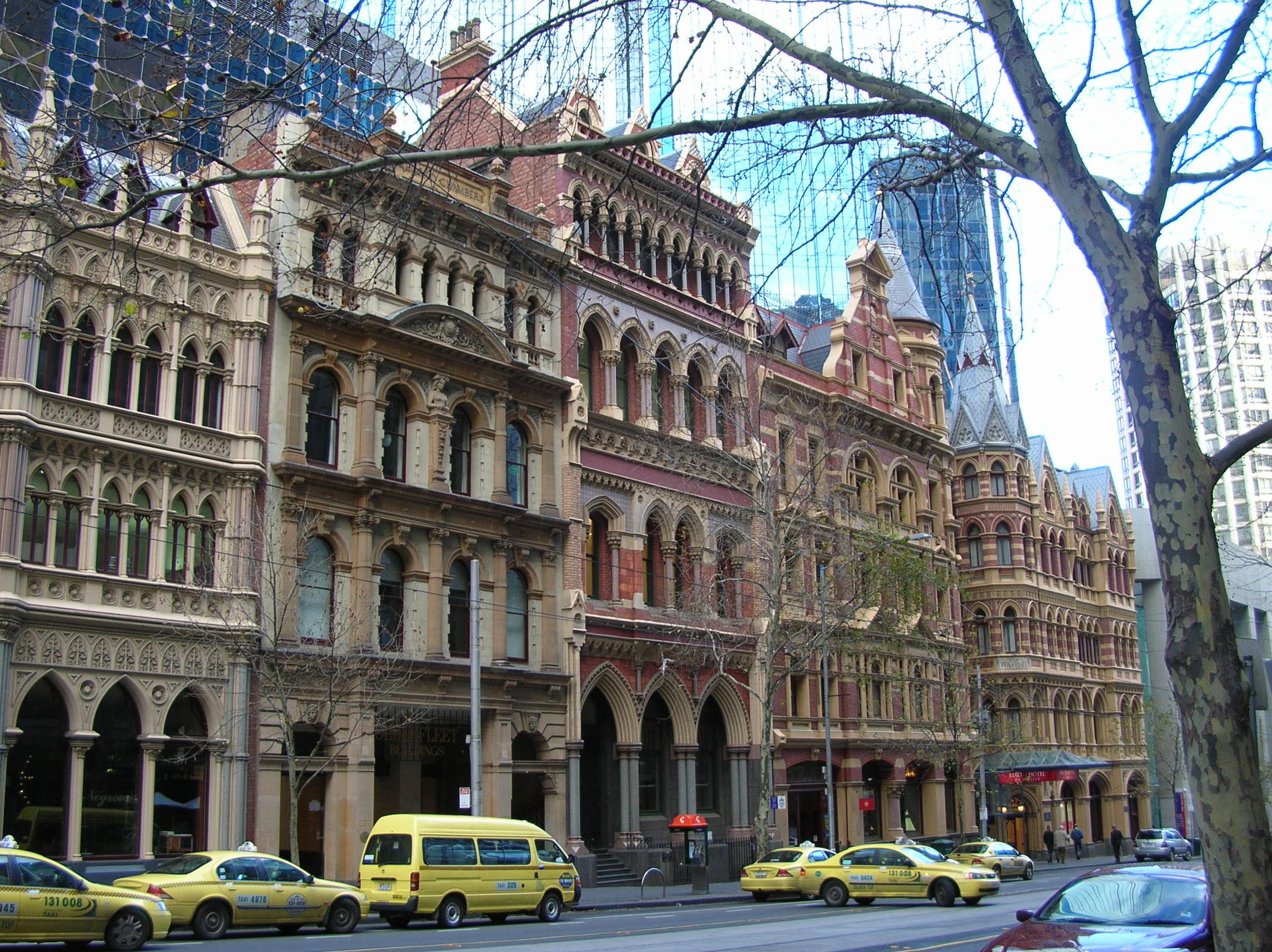 |
| Grand Victorian architecture, Collins Street, Melbourne CBD |
 |
| St Michael's Church, Collins Street, Melbourne |
 |
| Heritage facades between Flinders Lane and Collins Street on Elizabeth Street Melbourne |
 |
| Melbourne Chinatown, VIC, 2021, Andrew Ho |
 |
| Block Arcade, Melbourne, built 1892 |
 |
| Royal Arcade, Melbourne, opened in 1870 |
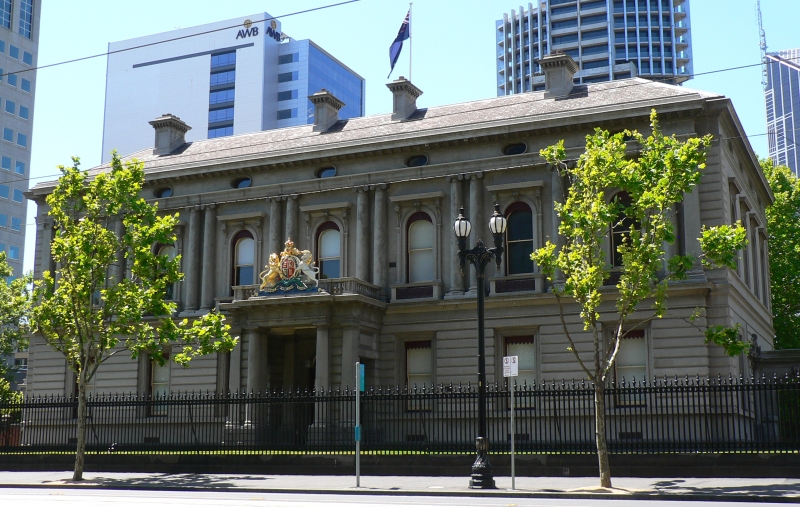 |
| The former Royal Mint, now Hellenic Museum, circa 1869 |
 |
| Her Majesty's Theatre, built 1886 |
 |
| China Town district, Melbourne |
 |
| The Forum Theatre (originally the State Theatre), built 1929 |
 |
| The Athenaeum, at 188 Collins Street was completed in 1842 |
 |
| Bryant & May Factory, Church Street, Richmond, Melbourne |
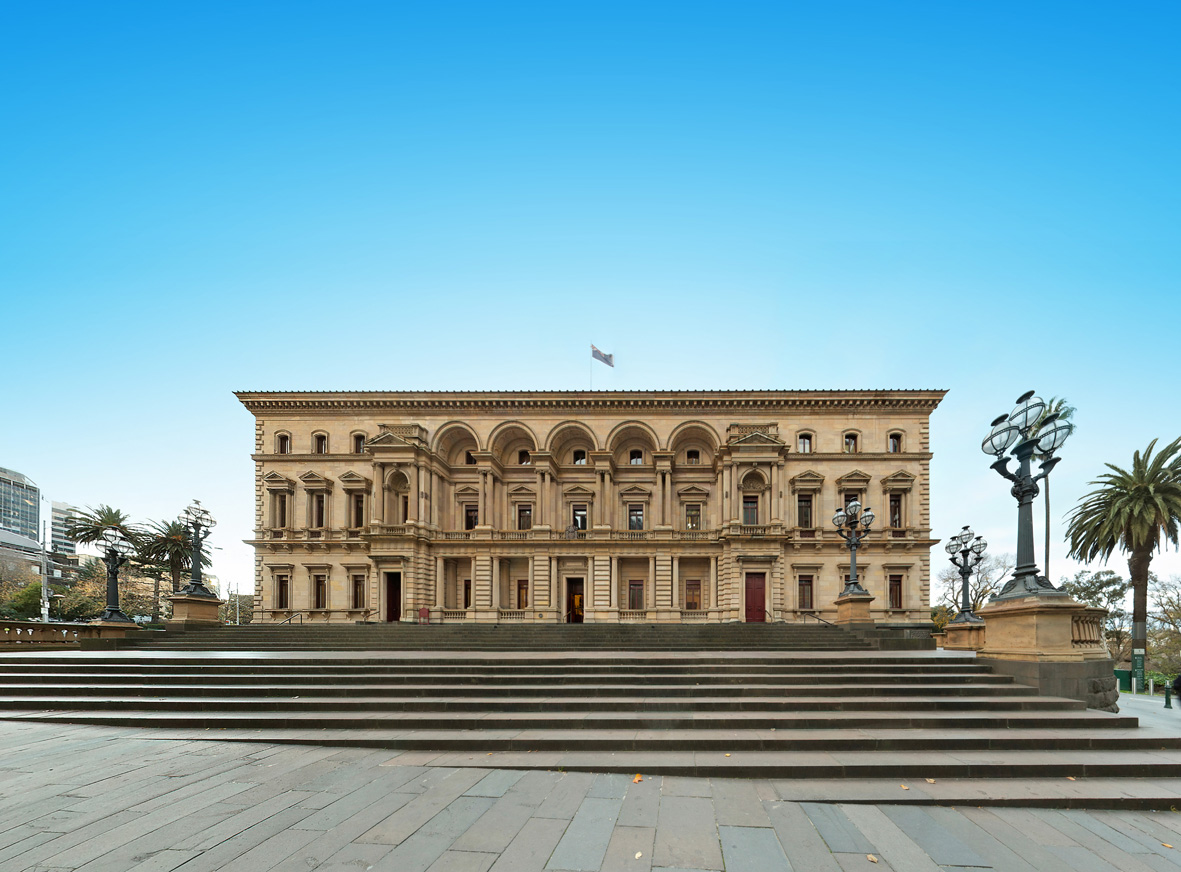 |
| The Old Treasury Building, Melbourne, Australia. Built in 1858-62 |
 |
| Victoria Barracks Melbourne, St Kilda Road, Melbourne. Construction began 1856 |
 |
| St Paul's, Melbourne, completed 1891 |
 |
| Victorian terraces, Middle Park, Melbourne |
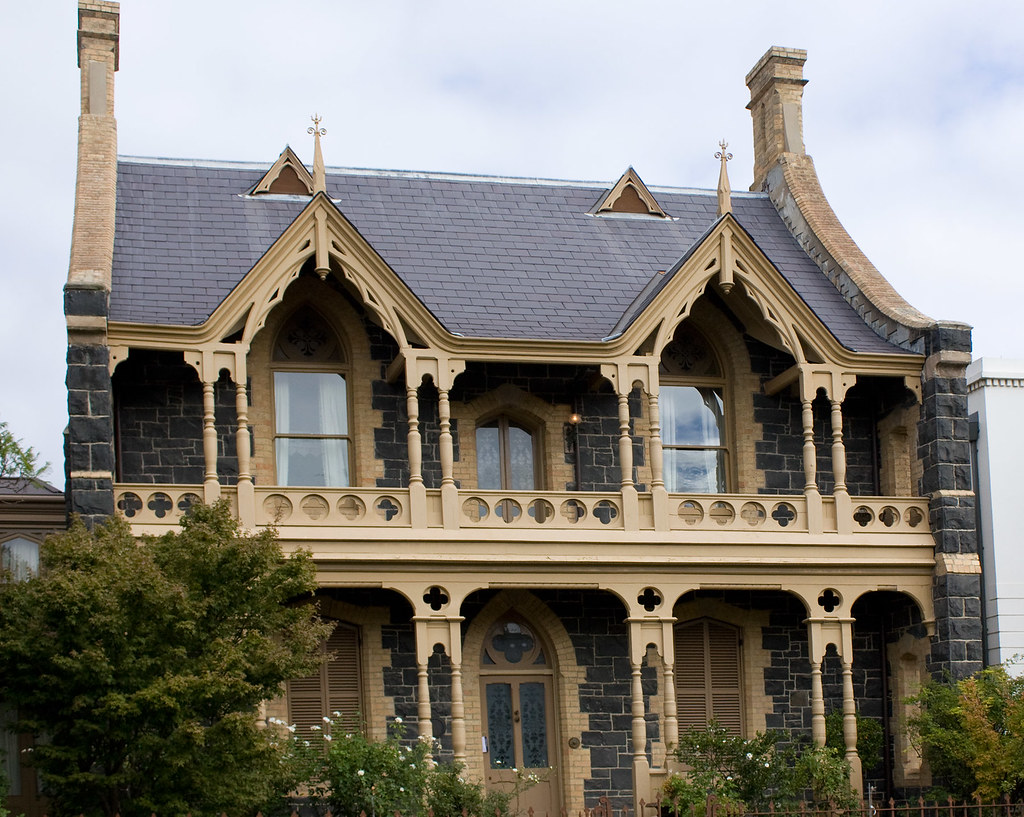 |
| Gothic style house, Hotham Street, East Melbourne. Rexness |
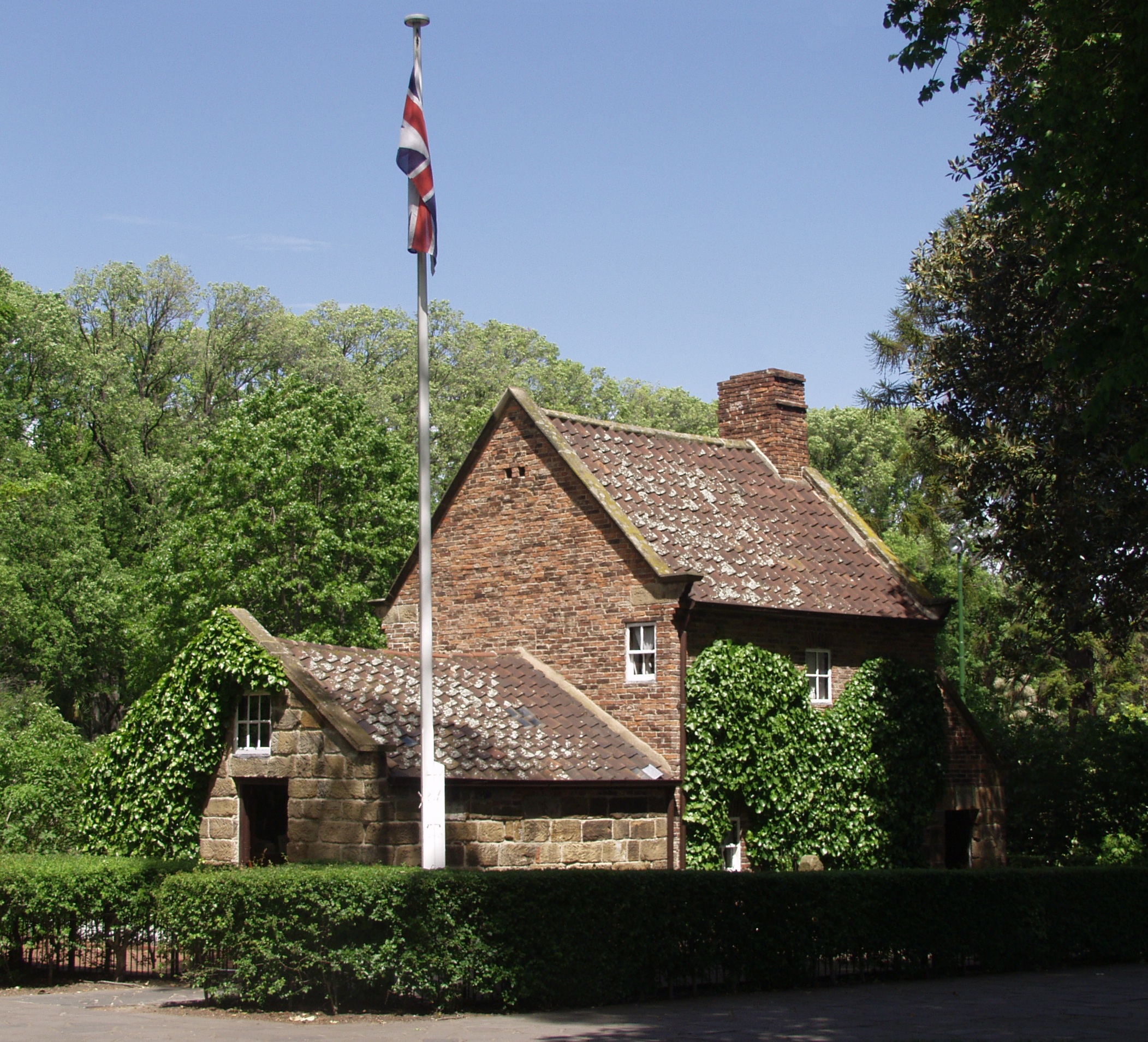 |
| Captain Cook's cottage is located in the Fitzroy Gardens, Melbourne, Australia. The cottage was constructed in 1755 Yorkshire, England and brought to Melbourne in 1934 |
 |
| Criminal property developers illegally tore down the heritage-listed Corkman Hotel, Carlton, Melbourne, in October, 2016. They should be made to rebuild it, brick by brick. |
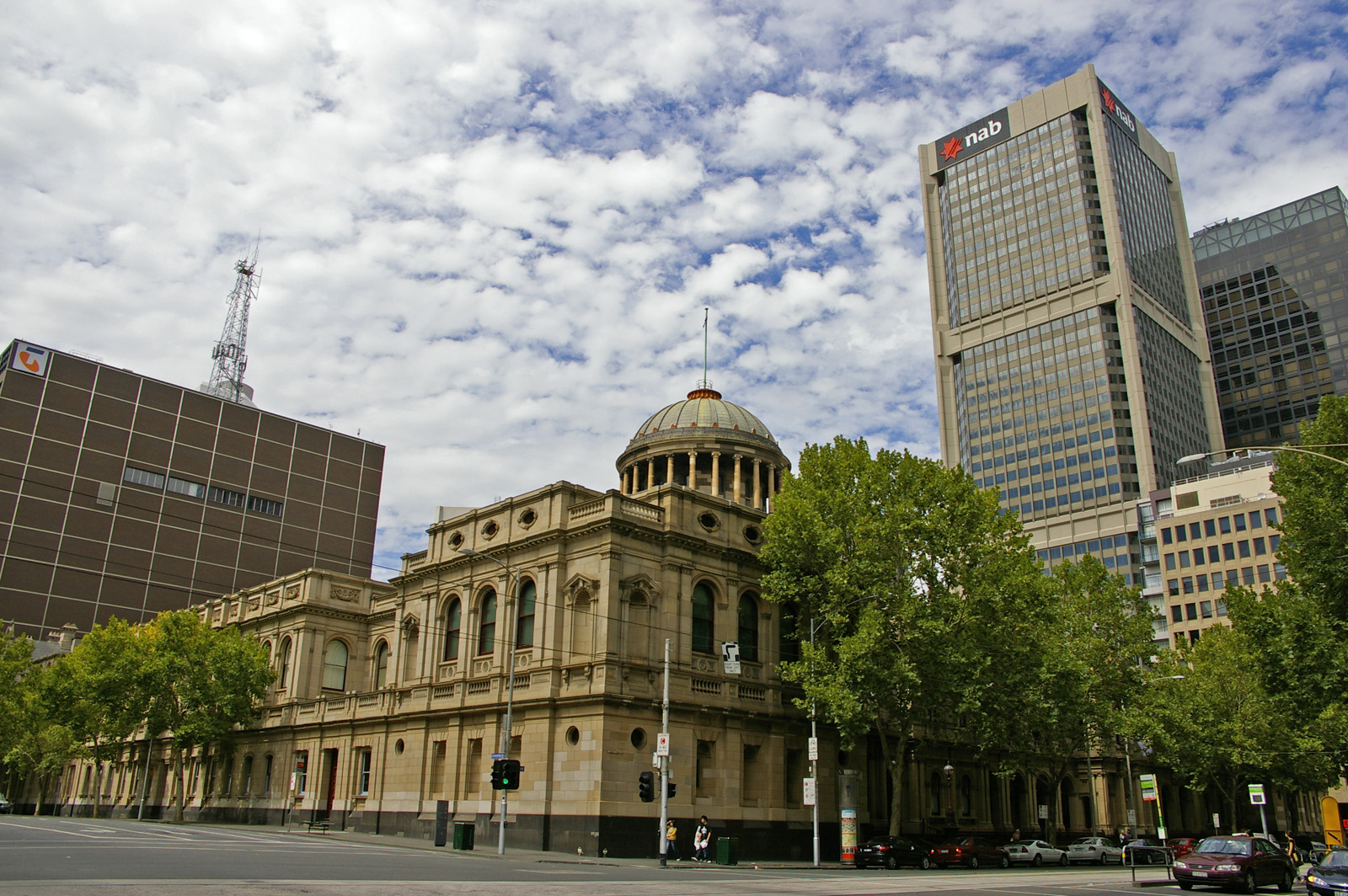 |
| Supreme Court of Victoria, established 1852 |
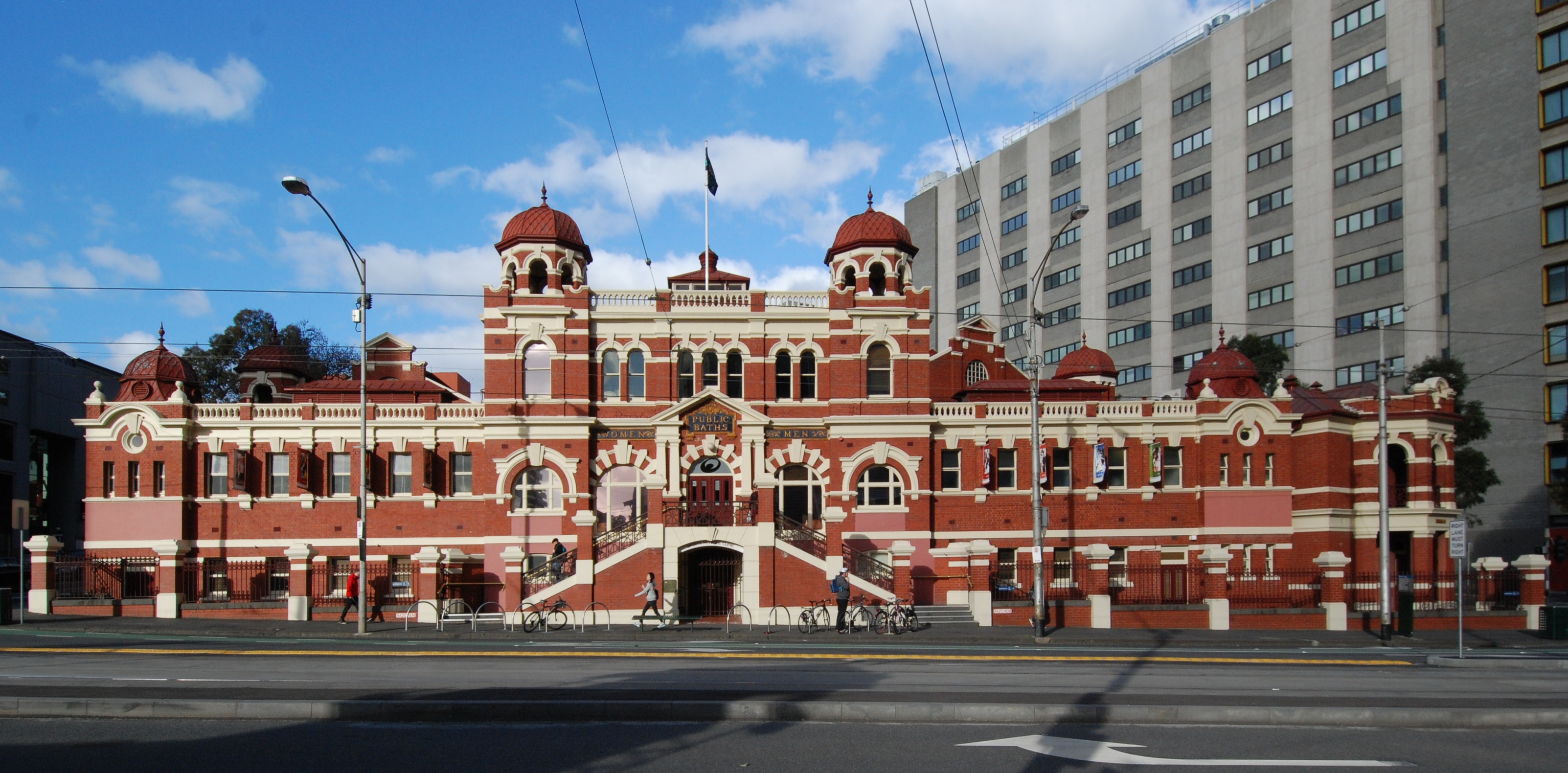 |
| The City Baths were built by Swanson Brothers builders in 1903-4 |
 |
| Government House was built between 1872 and 1876 |
 |
| The Royal Exhibition Building in Melbourne, Australia, was built in 1880 |
.jpg) |
| Greek Corinthian and Doric design is evident in the Victorian Parliament, on Spring Street, East Melbourne. Construction began in 1855 |
 |
| 28-330 King Street, the oldest residence in Melbourne, VIC (built 1850) |
 |
| Forum Melbourne (originally the State Theatre) on the corner of Flinders Street and Russell Street in Melbourne, Australia. Built in 1929, Dietmar Rabich |
 |
| Milton House on Flinders Lane in Melbourne, VIC, built 1901 Zigzig20s |
 |
| Mitchell House is a six-storey Streamline Moderne art-deco commercial building in Melbourne, VIC, completed 1937 |
Things To Do and Places To Go









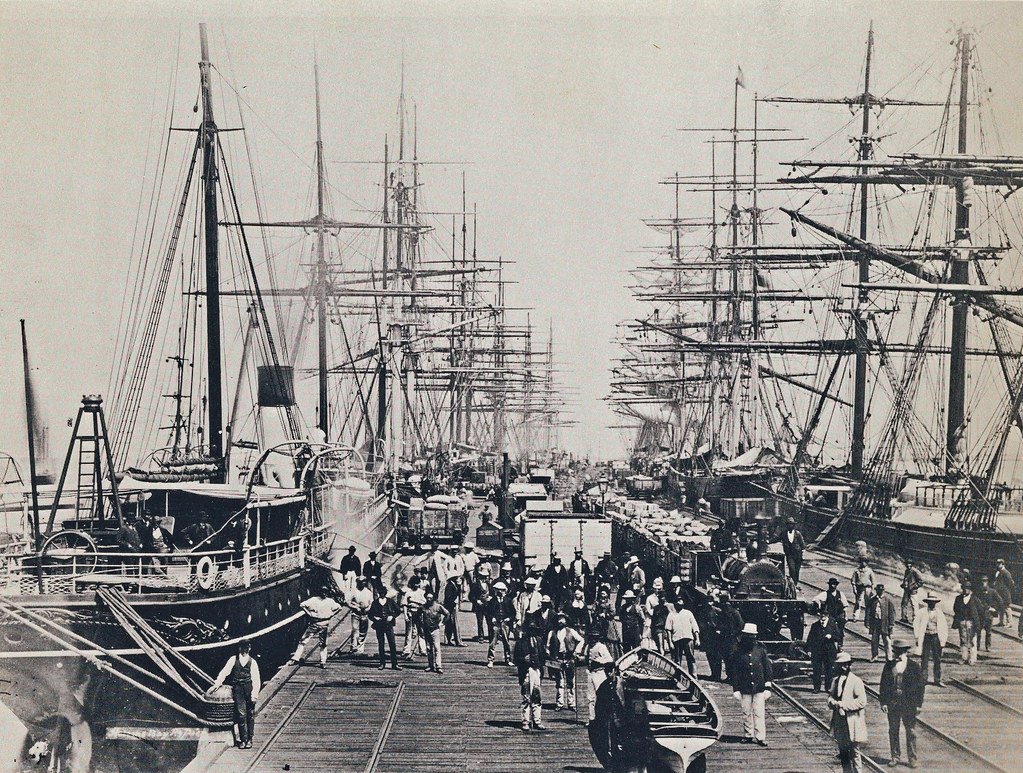























.jpg)





















































.jpg)









_p187_TASMANIA%2C_THE_LAST_OF_THE_ABORIGINALS_(LADY).jpg)
















